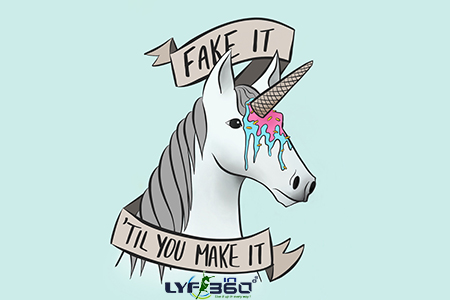
Fake It Till You Make It: The Confidence Hack That Actually Works
In a world obsessed with instant success, the phrase “Fake it till you make it” often raises eyebrows. Is it about pretending to be someone you’re not? Or is it about embodying the confidence of your future self until reality catches up?
Let’s dive deep into the power of this mindset—and how faking it the right way can help you actually make it.
What Does “Fake It Till You Make It” Actually Mean?
Let’s be honest—“faking” gets a bad rap. No one wants to be seen as a poser. But this idea isn’t about lying or pretending to be someone you’re not. It’s about acting with confidence before you feel it, showing up when your brain is still unsure, and creating behavior that gradually reshapes belief.
In psychology, this is backed by the self-perception theory, first proposed by Daryl Bem in the 1970s. The idea? People often come to understand their internal states by observing their external behavior. Meaning: You smile → You feel happier. You speak up in meetings → You start to think you’re someone worth listening to.
And there’s hard data behind this.
A 2012 study from Harvard Business School by Amy Cuddy found that holding “power poses” for just two minutes significantly increased testosterone (dominance hormone) and decreased cortisol (stress hormone). Translation? Your body tricks your brain.
Also Read: Welcome to 21st century | Take back your Remote
Why Faking Confidence Actually Works

Psychologists call this the “self-fulfilling prophecy”. When you carry yourself with confidence, even if it’s initially an act, you begin to influence how others perceive you—and how you perceive yourself.
This tactic works because:
- The brain doesn’t always distinguish between real and imagined confidence.
- You create new neural pathways that support growth.
- You attract opportunities by exuding competence and energy.
Whether you’re stepping into a new job, launching a startup, or just trying to level up in life, projecting self-assurance can open doors faster than waiting for perfection.
How to “Fake It” the Right Way
- Visualize Your Future Self: Clearly define who you want to become — confident leader, skilled coder, inspiring speaker — and start behaving like that person today.
- Dress the Part: Your appearance can affect your mindset. Dressing well isn’t vanity; it’s a form of preparation.
- Use Positive Self-Talk: Replace limiting beliefs with empowering statements. “I’m not good at this” becomes “I’m learning and improving.”
- Practice, Practice, Practice: Confidence without substance is shallow. Invest in learning so the “fake” transforms into the real.
- Surround Yourself with Inspiration: Spend time with people who embody the traits you admire. Their habits and energy will rub off on you.
Let’s Talk About the Line You Shouldn’t Cross
Of course, there’s a difference between stretching your confidence and stretching the truth.
Faking expertise you don’t have in high-stakes environments (finance, healthcare, structural engineering…) is dangerous. The key is honest ambition cloaked in courage, not delusion dressed as mastery.
Some red flags to avoid:
- Saying “yes” to a project you’re unqualified for without a plan to learn quickly
- Presenting false credentials or experience
- Avoiding feedback because it threatens the image you’re projecting
Faking it responsibly means you’re committed to becoming the thing you’re pretending to be, not just basking in the illusion.
In Conclusion
“Fake it till you make it” isn’t about being fake. It’s about believing in your potential, acting as if you belong—even if you’re still on the journey—and putting in the work to become who you aspire to be. Like any good mantra, it works best when rooted in honesty, growth, and self-awareness.
So go ahead—walk into that room like you belong there. Just make sure you’re also doing the work to actually earn your place.
Also Read: Take back your Remote



